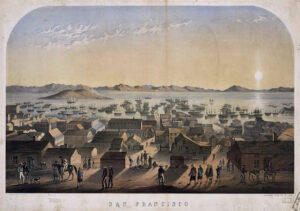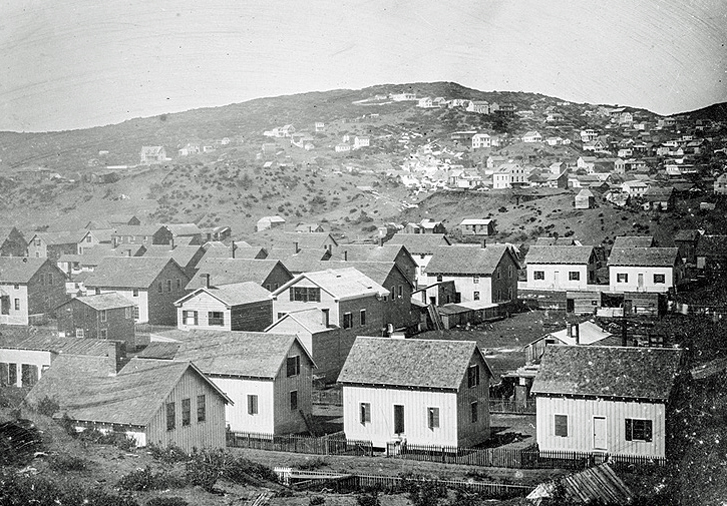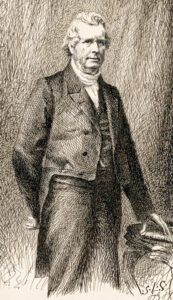True Tales from Canton’s Past: Around the Horn
By George T. ComeauAs the winter sun rose over Canton on February 8, 1849, Reverend Benjamin Huntoon took note that the temperature was six degrees. Turning to his son, Marcellus, he quipped, “Soon you will be basking in the sun with a fortune awaiting.” Already packed, under the watchful eye of his father, young Marcellus, not yet 23, was about to embark on a voyage that most would merely dream of. They called it the “mysterious Occident, where the very sands were golden, and alas, only man was vile.” Marcellus was off to discover gold!
In the 1840s there were a number of wealthy men with sons who wanted to stake their own claims of riches. Alonzo Kinsley, a close friend of Huntoon, explained how his father, the wealthy industrialist Alfred Kinsley, would pay for his passage “around the horn” to California. Indeed, the young Kinsley had booked passage on the barque Orb, which set sail from Boston on January 13, 1849. The ship was owned by the North Western Mining and Trading Company and was refit without any regard to cost. This was a luxury sailing vessel meant for men of means. Kinsley would have paid $1,000 to the common treasury for the voyage. Complete with all the mining equipment and even uniforms for the members, the Orb was the highest and best statement for what riches would lie ahead as the gold rush began.
Huntoon, on the other hand, had only a modest allowance for his adventure. He would follow his friend less than three weeks later aboard the barque Lanerk. Unlike Kinsley, Huntoon likely had his expenses paid by one of the gentlemen organizing the expedition. Shares for the voyage would be repaid from the earnings once gold was discovered in California. As noted in Argonauts of ’49 by Octavius Thorndike Howe, “So thoroughly convinced were the people of Massachusetts that gold could be acquired in California almost without exertion that it is probable that no honest and healthy man found any trouble in obtaining backers.”
Huntoon’s father had the foresight to prepare his son well. And at least three of his children would make the trip west at this same time. Marcellus kept a small diary that was formed within the pages of a Farmer’s Almanac. It seems that Marcellus’ brother John, aged 21, was along on the trip, but the ship’s record is not entirely clear.
What is clear is the details of the voyage. Stitched inside the leaves of the printed pages are the diary entries of one of the first settlers of the state of California. The details give us a glimpse into a shrouded life. Setting sail from Long Wharf on February 9 or 10, Huntoon embarked on a voyage that took 212 days. The diary records, in his father’s hand, the contents of the “black trunk,” “red trunk No. 1,” “green chest,” and “red trunk No. 2.”
What Huntoon carried from Canton on his trip to California is a study in how to prepare for the unknown and the frontier experience. The trunks and boxes contained a “medley of clothing, medicines, tools, books and sundries which had been provided by loving hearts and willing hands.”
A list was included that gave a bit more color to the things he carried forth: “a Bible and Testament and a pair of dancing pumps … Greenleaf’s Arithmetic and a pair of mittens; Shakespeare, Spanish without a Master, and the Lady of the Lake; a complete outfitting of comfortable clothing, with powder, balls, jack knives, fishing tackle and enough variety of useful and useless articles to start a general merchandise store in a mining camp.”
Huntoon’s diary tells the story of six months of the arduous 15,000-mile voyage around Cape Horn — and spectacularly describes the last few hours of the voyage. “Wednesday, September 12, 1849 – Half-past 5 a.m., weighing anchor; foggy; 6 a.m. getting under way with a fair wind and yards squared … half past 8 a.m.; can see Mile Rock at the entrance of San Francisco Bay; quarter past 9 a.m.; at the entrance of the bay; we are now passing an island on our left; it has a white appearance. As we are approaching the city we can see, at anchor, the ship of war Ohio, the frigate Savannah and the sloop Warren.”
As the details emerge, it is clear that gold fever is everywhere. Huntoon writes of men reporting plenty of gold in the mines, but more labor is required to get it. Moreover, he was pleased to learn that the autumn temperatures meant working in the mines would be more comfortable than during the past summer. Sickness spread through the camps as dysentery and scurvy ran rampant in close quarters. Huntoon observed that “many of the New Englanders camp together in a place they call Happy Valley in San Francisco.”
Marcellus’ brother John is also mentioned in the diary. “Thursday, Sep. 13; my brother John and myself went on shore in the captain’s small boat. In less than a quarter of an hour after we left the vessel we were landed at the famous city of San Francisco, which contains about 200 houses and is situated on the right hand side of the bay, coming in from the Golden Gate. Some parts of the city are situated on the hillside, but the principal part is on the plain. We found the streets very dusty and heavy with sand. I went to a small shop where I saw some gold washing cradles with iron sieves; I asked the shopkeeper what he charged for one and he said twenty-five dollars.”

A view of San Francisco in 1849 as the Huntoon boys arrived (Library of Congress) Click image to enlarge.
Both brothers found their place in California. They arrived in time to cast their votes for statehood. Gold had been discovered in January 1848, and the young Canton men landed in September 1849 as the gold rush began. Alonzo Kinsley had found gold and was doing quite well. Selling a single nugget netted Kinsley $1,250 — an amount equal to $44,000 today. The Huntoon brothers found other diversions. Lawlessness prevailed, and both men became members of the famed Vigilantes and meted out “righteous wrath.”
In 1851, a group of San Francisco merchants established the “Committee of Vigilance.” Meeting in secret, the 700-member group announced that San Francisco’s elected government was incapable of protecting the life and property of the city’s citizens and took matters into their own hands. An entry on the website Legends of America notes, “Their justice was swift and sure, hanging four men accused of murder. Word of their deeds of lynching and excommunicating criminals spread fast, and San Francisco’s crime rate declined rapidly.”
At least two other Huntoon brothers would join John and Marcellus out west for the gold rush. John went on to become quite wealthy and emigrated to Idaho in 1864, where he became a banker and served as the territorial treasurer for four years. Marcellus and a third brother, Isaac, were also alongside and participated in the creation of at least three boomtowns in what would become Skagit County in the Northern Cascades of Washington State. Isaac moved to Montana and later back to San Francisco and was a merchant there in 1871. Marcellus became the first homestead claimant on Washington’s Olympic Peninsula. General Land Office records indicate that he first settled the site on Christmas Day in 1861, and two months later took up permanent residence in the “good, comfortable hewed-log dwelling” he built on the site. Over the course of the next 10 years, Huntoon also built two hay sheds and cleared 30 acres of his land. He received his title patent to the parcel in June 1873.
By 1899, more than 50 years since the two brothers arrived in California, they were in the twilight of their lives. In a letter to Marcellus that was printed in the Evening Sentinel in Santa Cruz, California, John wrote, “We surely have been on the side of law and order and worked for good schools, helped to build 9,000 schools and voted to keep slavery out of California; and advocated good government and helped to maintain the laws of the state under which we lived, all of which we need not take much credit to ourselves for as we were naturally carrying out the principles inculcated in our New England education and our Christian home influences.”
Casting his eye towards the end of his life, the brother notes, “We can’t expect to be long remembered. The coming generation will be too busy to remember that we ever lived and even if they did the next generation would not know anything about us. Even supposing we had secured riches and honors, how much longer would we be remembered say even 100 years? What would that amount to? So I don’t see as we need trouble ourselves whether we are remembered or not after we have passed away, as it will not avail anything one way or the other. If this world is all there is and there is no hereafter, life would hardly be worth living. Vain is the pomp and glory of the world! All so soon passes away. What the world thinks of us after we are dead will not affect us. Dear me, of how little importance we are, especially after we get old.”
This dark letter dwelled on the philosophy of life and clearly left a mark on Marcellus. John died in 1902 at age 74. In 1904 Marcellus attempted to take his own life as he considered himself a “burden to the people assisting him.” Committed to an institution, he lived his last days in solitude and died in 1908.
So little is known of this man from Canton, but what giant he must have been. A letter written to Marcellus in 1902 by Senator John Conness seems to sum up this pioneer: “The transfer of 100,000 men in a single year fixed upon California the status of freedom as that of the fairest land man ever looked upon. Thus the fairest land was made the freest by a year’s single effort; and you and I, who had a hand in this, are now passing down and out of the line. There was no completeness in American continental life until this great movement of men was made — the very top sheaf of wheat was and is California.”
Short URL: https://www.thecantoncitizen.com/?p=91420












